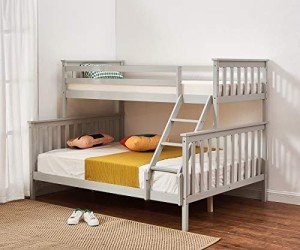
Childrens Bed With Slide
Add a review FollowOverview
-
Founded Date 26 mars 2001
-
Sectors MARKETING
-
Posted Jobs 0
-
Viewed 4
Company Description
The Largest Issue That Comes With Slide Bed, And How You Can Repair It
Understanding Slide Beds: A Comprehensive Overview
Intro
Slide beds represent an advanced advancement in the field of transportation and logistics, especially in the context of the trucking industry. These specialized beds provide enhanced filling and unloading capabilities, increased efficiency, and better safety requirements. As the need for logistics services becomes more sophisticated, slide beds emerge as an important tool for companies seeking to optimize their operations. This short article delves into the numerous elements of slide beds, including their style, advantages, types, and maintenance factors to consider.
What is a Slide Bed?
A slide bed, frequently described as a moving truck bed or slide-out bed, is a type of truck bed created to extend and retract, allowing for easier access to freight. These beds can slide out either manually or through automated systems, facilitating loading and discharging while reducing the stress on employees.
How Do Slide Beds Work?
The performance of slide beds can vary based upon their design:
-
Manual Slide Beds: These beds need one or more people to pull or push the bed out. While simple and affordable, manual slide beds might not be appropriate for sturdy applications.
-
Automated Slide Beds: These beds operate through hydraulic or electrical systems that permit uncomplicated extension and retraction at the push of a button. Automated systems often include safety functions to prevent mishaps during operation.
The basic operation of these systems can be summed up in the following table:
| Type | Mechanism | Use | Pros | Cons |
|---|---|---|---|---|
| Manual Slide Beds | Pull/push operation | Light to medium loads | Lower expense | Needs physical labor |
| Automated Slide Beds | Hydraulic/Electric | Heavy loads and frequent usage | Convenience and efficiency | Higher preliminary financial investment |
Advantages of Using Slide Beds
Slide beds use a number of advantages that make them an attractive alternative for services in different sectors. These advantages can be classified into operational performance, security, and cost-effectiveness:
Operational Efficiency
- Easy Access: Slide beds permit employees to reach freight without having to climb up into the truck or maneuver around tight areas.
- Time-Saving: Quick loading and discharging mean decreased turnaround times for automobiles, leading to increased performance.
- Better Space Utilization: The ability to extend the bed indicates that freight can be arranged more effectively, facilitating much better usage of space.
Safety
- Reduced Injury Risk: With easy access to cargo, the probability of musculoskeletal injuries reduces substantially.
- Boosted Stability: Slide beds are developed to accommodate much heavier loads more evenly, improving vehicle stability.
Cost-Effectiveness
- Increased Payload Capacity: Slide beds enable for greater volume transport without making considerable adjustments to lorries.
- Long-Term Durability: Investing in a quality slide bed can lead to lowered upkeep expenses over time.
Types of Slide Beds
There are a number of types of slide beds offered in the market, each dealing with different needs and applications. Here are the most common types:
- Standard Slide Beds: These are the most widespread and serve general functions throughout numerous sectors.
- Durable Slide Beds: Designed for bigger vehicles and much heavier loads, these beds enhance structural stability.
- Customized Slide Beds: Customized solutions deal with particular industry needs, such as animals transport or specific equipment.
Slide Bed Types Comparison
| Type | Perfect Use | Maximum Load Capacity | Customization Options |
|---|---|---|---|
| Standard Slide Beds | General transport | Up to 3,000 pounds | Limited |
| Sturdy Slide Beds | Industrial and building and construction | Over 3,000 pounds | Available |
| Customized Slide Beds | Specialized transport requires | Varies by style | Highly customizable |
Upkeep Considerations
Maintaining a slide Panana Wooden Bunk Bed With Fun Slide for Kids is important to ensure its durability and ideal efficiency. Here are important upkeep tips:
- Regular Inspections: Routinely inspect for wear and tear, making sure that all moving parts are working properly.
- Lubrication: Keep moving components well-lubricated to minimize friction and prevent rust.
- Tidiness: Regularly tidy the slide bed to remove debris and impurities that might interfere with operations.
- Tighten Fasteners: Periodically ensure that all bolts and screws are tightened to avoid structural failure.
Frequently Asked Questions About Slide Beds
Q1: Are slide beds appropriate for all types of trucks?A1: While slide beds can be adjusted for a range of truck designs, it is essential to seek advice from a professional to ensure compatibility.
Q2: How much weight can a slide bed hold?A2: The weight capacity of slide beds varies commonly; standard slide beds generally hold up to 3,000 pounds, while sturdy choices can accommodate much more.
Q3: How typically should slide beds be maintained?A3: Regular maintenance is important; examinations ought to be performed at least every 6 months, with more regular checks advised for heavy-use automobiles.
Q4: Can I personalize a slide bed for my specific needs?A4: Yes, lots of producers offer personalization alternatives to accommodate industry-specific requirements.
Conclusion
Slide beds are quickly becoming among the most efficient solutions for enhancing logistics operations. With their capability to enhance access to freight and assist in quicker loading and discharging processes, they exhibit a mixing of innovation and energy that resolves the needs of modern-day transportation. By selecting the right kind of slide bed and maintaining it correctly, organizations can considerably improve their operational effectiveness, safety, and cost-effectiveness. The future looks promising for slide beds, as they continue to evolve and fulfill the growing demands of the logistics industry.
